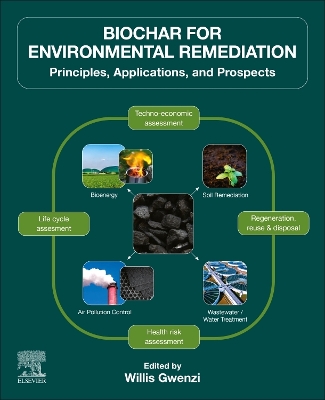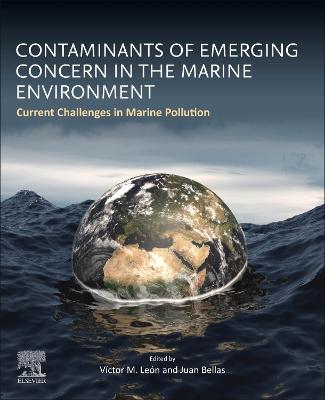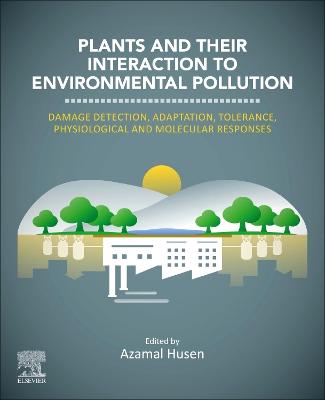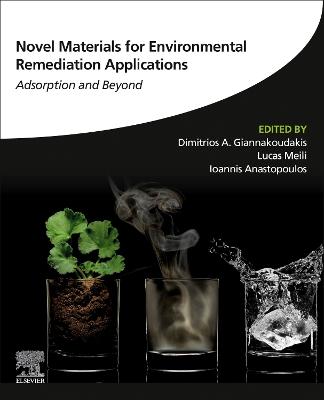Biochar for Environmental Remediation
 -10%
portes grátis
-10%
portes grátis
Biochar for Environmental Remediation
Principles, Applications, and Prospects
Gwenzi, Willis
Elsevier - Health Sciences Division
01/2025
532
Mole
Inglês
9780323998895
15 a 20 dias
Descrição não disponível.
Part 1Biochar technology: fundamental principles
1. Biochar for environmental remediation at a glance: principles, applications, and prospects
2. Feedstocks, preparation, and characteristics of pristine biochars
3. Development of novel engineered/functionalized biochars
4. Design, characterization, and evaluation of biochar: recent advances, applications, and future research directions
5. Harnessing biochar for sustainable catalysis in environmental applications
Part 2 Biochar for contaminated land remediation
6. Biochar remediation of inorganic contaminants in soils
7. Biochars for the remediation and repurposing of postmining landscapes and metalliferous substrates: applications and future perspectives
8. Biochar remediation of conventional and emerging organic contaminants in soils
9. Biochar for remediation of petroleum hydrocarbons in soil, sediments, and sludge
Part 3 Biochar for water and wastewater treatment
10. Removal of contaminants in drinking water using biochars
11. Biowaste-derived biochars for treatment of wastewater contaminated by dyes
12. Removal of per- and polyfluoroalkyl substances in environmental matrices by biochars: mechanisms, fate, and research needs
13. Application of biochar for the treatment of urban stormwater: processes and future directions
14. Treatment of industrial and municipal wastewaters using biochar: performance, mechanisms, and research needs
Part 4 Biochar sytems for clean and renewable energy
15. Electrochemical properties of biochar for environmental applications: advances, challenges, and perspectives
16. Biochar in bioelectrochemical systems: applications and future directions
17. Thermochemical treatment of human excreta to energy and biochar: recent advances, applications, and future directions
Part 5 Biochar systems for air pollution control
18. Clean and efficient biochar cookstoves for mitigation of indoor air pollution
19. Biochars for the removal of toxic gaseous contaminants: state-of-the-art and future directions
Part 6 Assessment of biochar systems
20. Regeneration, recycling, and disposal of spent biochars
21. Life cycle assessment for biochar systems: a review
22. Potential environmental and human health risks of biochar systems: a call for comprehensive health risk assessments
23. Techno-economic assessment of biochar systems: state-of-the-art and future research directions
Part 7 Looking ahead: future perspectives and epilogue
24. Biochar for environmental remediation and beyond: a "twin or multiple solutions" heuristic framework for uptake, adoption, and impact
25. Moving ahead with biochar for environmental remediation and beyond: future research directions, roadmap, and epilogue
1. Biochar for environmental remediation at a glance: principles, applications, and prospects
2. Feedstocks, preparation, and characteristics of pristine biochars
3. Development of novel engineered/functionalized biochars
4. Design, characterization, and evaluation of biochar: recent advances, applications, and future research directions
5. Harnessing biochar for sustainable catalysis in environmental applications
Part 2 Biochar for contaminated land remediation
6. Biochar remediation of inorganic contaminants in soils
7. Biochars for the remediation and repurposing of postmining landscapes and metalliferous substrates: applications and future perspectives
8. Biochar remediation of conventional and emerging organic contaminants in soils
9. Biochar for remediation of petroleum hydrocarbons in soil, sediments, and sludge
Part 3 Biochar for water and wastewater treatment
10. Removal of contaminants in drinking water using biochars
11. Biowaste-derived biochars for treatment of wastewater contaminated by dyes
12. Removal of per- and polyfluoroalkyl substances in environmental matrices by biochars: mechanisms, fate, and research needs
13. Application of biochar for the treatment of urban stormwater: processes and future directions
14. Treatment of industrial and municipal wastewaters using biochar: performance, mechanisms, and research needs
Part 4 Biochar sytems for clean and renewable energy
15. Electrochemical properties of biochar for environmental applications: advances, challenges, and perspectives
16. Biochar in bioelectrochemical systems: applications and future directions
17. Thermochemical treatment of human excreta to energy and biochar: recent advances, applications, and future directions
Part 5 Biochar systems for air pollution control
18. Clean and efficient biochar cookstoves for mitigation of indoor air pollution
19. Biochars for the removal of toxic gaseous contaminants: state-of-the-art and future directions
Part 6 Assessment of biochar systems
20. Regeneration, recycling, and disposal of spent biochars
21. Life cycle assessment for biochar systems: a review
22. Potential environmental and human health risks of biochar systems: a call for comprehensive health risk assessments
23. Techno-economic assessment of biochar systems: state-of-the-art and future research directions
Part 7 Looking ahead: future perspectives and epilogue
24. Biochar for environmental remediation and beyond: a "twin or multiple solutions" heuristic framework for uptake, adoption, and impact
25. Moving ahead with biochar for environmental remediation and beyond: future research directions, roadmap, and epilogue
Este título pertence ao(s) assunto(s) indicados(s). Para ver outros títulos clique no assunto desejado.
Adsorption; Adsorption mechanism; Agricultural soil science; Applications; Behavior and fate; Biochar; Biochar application domains; Biochar applications; Biochar boundaries; Biochar catalysts; Biochar principles; Biochar production methods; Biochar-based solutions; Biochar-derived contaminants; Biochar-mediated processes; Biomass; Biomass feedstock; Biomass feedstock types; Biowaste; Catalysis; Catalyst poisoning; Characterization; Charcoal; Chemical compound; Climate change; Combustion; Combustion efficiency; Conceptual framework; Contamination; Cookstoves; Decision-support tools; Disposal; Ecological health risks; Ecological risks; Energy Sustainability; Energy sustainability; Energy-water-food-environment nexus; Environmental Bioengineering; Environmental Pollution; Environmental biotechnology; Environmental chemical engineering; Environmental engineering; Environmental health risks; Environmental impacts; Environmental indicators; Environmental management; Environmental pollution; Environmental remediation; Environmental risk assessment; Environmental risks; Fate and behavior; Gaseous contaminants; Gasification; Goal and scope definition; Grand questions; Greenhouse gas emissions; Hazardous waste; Health risk; Health risk assessments; Heavy metals; Human excreta to energy; Human health risks; Indoor gaseous pollutants; Industrial and municipal wastewater treatment; Inorganic contaminants; Knowledge gaps; Land rehabilitation; Life cycle assessment; Life cycle impact assessment; Life cycle inventory; Materials application; Mechanisms; Metal-enriched substrates; Microbial fuel cell; Microorganisms; Multiple functions; Natural resources; Oily sludge; Organic contaminants; PFAS; Petroleum hydrocarbons; Petroleum sludge; Physicochemical properties; Pollutant control; Pollutant removal; Pollutants; Pollution risks; Potable water; Power density; Power generation; Preparation techniques; Pyrolysis; Recycling; Regeneration technologies; Remediation; Removal efficiency; Removal mechanism; Removal mechanisms; Research nneeds; Resource-poor environment
Part 1Biochar technology: fundamental principles
1. Biochar for environmental remediation at a glance: principles, applications, and prospects
2. Feedstocks, preparation, and characteristics of pristine biochars
3. Development of novel engineered/functionalized biochars
4. Design, characterization, and evaluation of biochar: recent advances, applications, and future research directions
5. Harnessing biochar for sustainable catalysis in environmental applications
Part 2 Biochar for contaminated land remediation
6. Biochar remediation of inorganic contaminants in soils
7. Biochars for the remediation and repurposing of postmining landscapes and metalliferous substrates: applications and future perspectives
8. Biochar remediation of conventional and emerging organic contaminants in soils
9. Biochar for remediation of petroleum hydrocarbons in soil, sediments, and sludge
Part 3 Biochar for water and wastewater treatment
10. Removal of contaminants in drinking water using biochars
11. Biowaste-derived biochars for treatment of wastewater contaminated by dyes
12. Removal of per- and polyfluoroalkyl substances in environmental matrices by biochars: mechanisms, fate, and research needs
13. Application of biochar for the treatment of urban stormwater: processes and future directions
14. Treatment of industrial and municipal wastewaters using biochar: performance, mechanisms, and research needs
Part 4 Biochar sytems for clean and renewable energy
15. Electrochemical properties of biochar for environmental applications: advances, challenges, and perspectives
16. Biochar in bioelectrochemical systems: applications and future directions
17. Thermochemical treatment of human excreta to energy and biochar: recent advances, applications, and future directions
Part 5 Biochar systems for air pollution control
18. Clean and efficient biochar cookstoves for mitigation of indoor air pollution
19. Biochars for the removal of toxic gaseous contaminants: state-of-the-art and future directions
Part 6 Assessment of biochar systems
20. Regeneration, recycling, and disposal of spent biochars
21. Life cycle assessment for biochar systems: a review
22. Potential environmental and human health risks of biochar systems: a call for comprehensive health risk assessments
23. Techno-economic assessment of biochar systems: state-of-the-art and future research directions
Part 7 Looking ahead: future perspectives and epilogue
24. Biochar for environmental remediation and beyond: a "twin or multiple solutions" heuristic framework for uptake, adoption, and impact
25. Moving ahead with biochar for environmental remediation and beyond: future research directions, roadmap, and epilogue
1. Biochar for environmental remediation at a glance: principles, applications, and prospects
2. Feedstocks, preparation, and characteristics of pristine biochars
3. Development of novel engineered/functionalized biochars
4. Design, characterization, and evaluation of biochar: recent advances, applications, and future research directions
5. Harnessing biochar for sustainable catalysis in environmental applications
Part 2 Biochar for contaminated land remediation
6. Biochar remediation of inorganic contaminants in soils
7. Biochars for the remediation and repurposing of postmining landscapes and metalliferous substrates: applications and future perspectives
8. Biochar remediation of conventional and emerging organic contaminants in soils
9. Biochar for remediation of petroleum hydrocarbons in soil, sediments, and sludge
Part 3 Biochar for water and wastewater treatment
10. Removal of contaminants in drinking water using biochars
11. Biowaste-derived biochars for treatment of wastewater contaminated by dyes
12. Removal of per- and polyfluoroalkyl substances in environmental matrices by biochars: mechanisms, fate, and research needs
13. Application of biochar for the treatment of urban stormwater: processes and future directions
14. Treatment of industrial and municipal wastewaters using biochar: performance, mechanisms, and research needs
Part 4 Biochar sytems for clean and renewable energy
15. Electrochemical properties of biochar for environmental applications: advances, challenges, and perspectives
16. Biochar in bioelectrochemical systems: applications and future directions
17. Thermochemical treatment of human excreta to energy and biochar: recent advances, applications, and future directions
Part 5 Biochar systems for air pollution control
18. Clean and efficient biochar cookstoves for mitigation of indoor air pollution
19. Biochars for the removal of toxic gaseous contaminants: state-of-the-art and future directions
Part 6 Assessment of biochar systems
20. Regeneration, recycling, and disposal of spent biochars
21. Life cycle assessment for biochar systems: a review
22. Potential environmental and human health risks of biochar systems: a call for comprehensive health risk assessments
23. Techno-economic assessment of biochar systems: state-of-the-art and future research directions
Part 7 Looking ahead: future perspectives and epilogue
24. Biochar for environmental remediation and beyond: a "twin or multiple solutions" heuristic framework for uptake, adoption, and impact
25. Moving ahead with biochar for environmental remediation and beyond: future research directions, roadmap, and epilogue
Este título pertence ao(s) assunto(s) indicados(s). Para ver outros títulos clique no assunto desejado.
Adsorption; Adsorption mechanism; Agricultural soil science; Applications; Behavior and fate; Biochar; Biochar application domains; Biochar applications; Biochar boundaries; Biochar catalysts; Biochar principles; Biochar production methods; Biochar-based solutions; Biochar-derived contaminants; Biochar-mediated processes; Biomass; Biomass feedstock; Biomass feedstock types; Biowaste; Catalysis; Catalyst poisoning; Characterization; Charcoal; Chemical compound; Climate change; Combustion; Combustion efficiency; Conceptual framework; Contamination; Cookstoves; Decision-support tools; Disposal; Ecological health risks; Ecological risks; Energy Sustainability; Energy sustainability; Energy-water-food-environment nexus; Environmental Bioengineering; Environmental Pollution; Environmental biotechnology; Environmental chemical engineering; Environmental engineering; Environmental health risks; Environmental impacts; Environmental indicators; Environmental management; Environmental pollution; Environmental remediation; Environmental risk assessment; Environmental risks; Fate and behavior; Gaseous contaminants; Gasification; Goal and scope definition; Grand questions; Greenhouse gas emissions; Hazardous waste; Health risk; Health risk assessments; Heavy metals; Human excreta to energy; Human health risks; Indoor gaseous pollutants; Industrial and municipal wastewater treatment; Inorganic contaminants; Knowledge gaps; Land rehabilitation; Life cycle assessment; Life cycle impact assessment; Life cycle inventory; Materials application; Mechanisms; Metal-enriched substrates; Microbial fuel cell; Microorganisms; Multiple functions; Natural resources; Oily sludge; Organic contaminants; PFAS; Petroleum hydrocarbons; Petroleum sludge; Physicochemical properties; Pollutant control; Pollutant removal; Pollutants; Pollution risks; Potable water; Power density; Power generation; Preparation techniques; Pyrolysis; Recycling; Regeneration technologies; Remediation; Removal efficiency; Removal mechanism; Removal mechanisms; Research nneeds; Resource-poor environment





